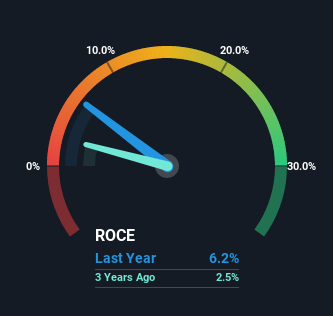Deutsche Lufthansa's (ETR:LHA) Returns On Capital Not Reflecting Well On The Business

When it comes to investing, there are some useful financial metrics that can warn us when a business is potentially in trouble. When we see a declining return on capital employed (ROCE) in conjunction with a declining base of capital employed, that's often how a mature business shows signs of aging. Basically the company is earning less on its investments and it is also reducing its total assets. So after glancing at the trends within Deutsche Lufthansa (ETR:LHA), we weren't too hopeful.
Return On Capital Employed (ROCE): What Is It?
For those that aren't sure what ROCE is, it measures the amount of pre-tax profits a company can generate from the capital employed in its business. To calculate this metric for Deutsche Lufthansa, this is the formula:
Return on Capital Employed = Earnings Before Interest and Tax (EBIT) ÷ (Total Assets - Current Liabilities)
0.062 = €1.5b ÷ (€45b - €20b) (Based on the trailing twelve months to March 2023).
Thus, Deutsche Lufthansa has an ROCE of 6.2%. Ultimately, that's a low return and it under-performs the Airlines industry average of 13%.
View our latest analysis for Deutsche Lufthansa

Above you can see how the current ROCE for Deutsche Lufthansa compares to its prior returns on capital, but there's only so much you can tell from the past. If you'd like, you can check out the forecasts from the analysts covering Deutsche Lufthansa here for free.
What The Trend Of ROCE Can Tell Us
In terms of Deutsche Lufthansa's historical ROCE movements, the trend doesn't inspire confidence. To be more specific, the ROCE was 14% five years ago, but since then it has dropped noticeably. Meanwhile, capital employed in the business has stayed roughly the flat over the period. Companies that exhibit these attributes tend to not be shrinking, but they can be mature and facing pressure on their margins from competition. So because these trends aren't typically conducive to creating a multi-bagger, we wouldn't hold our breath on Deutsche Lufthansa becoming one if things continue as they have.
On a side note, Deutsche Lufthansa's current liabilities are still rather high at 45% of total assets. This effectively means that suppliers (or short-term creditors) are funding a large portion of the business, so just be aware that this can introduce some elements of risk. While it's not necessarily a bad thing, it can be beneficial if this ratio is lower.
The Bottom Line On Deutsche Lufthansa's ROCE
In summary, it's unfortunate that Deutsche Lufthansa is generating lower returns from the same amount of capital. Investors haven't taken kindly to these developments, since the stock has declined 42% from where it was five years ago. With underlying trends that aren't great in these areas, we'd consider looking elsewhere.
On a final note, we've found 1 warning sign for Deutsche Lufthansa that we think you should be aware of.
For those who like to invest in solid companies, check out this free list of companies with solid balance sheets and high returns on equity.
New: Manage All Your Stock Portfolios in One Place
We've created the ultimate portfolio companion for stock investors, and it's free.
• Connect an unlimited number of Portfolios and see your total in one currency
• Be alerted to new Warning Signs or Risks via email or mobile
• Track the Fair Value of your stocks
Have feedback on this article? Concerned about the content? Get in touch with us directly. Alternatively, email editorial-team (at) simplywallst.com.
This article by Simply Wall St is general in nature. We provide commentary based on historical data and analyst forecasts only using an unbiased methodology and our articles are not intended to be financial advice. It does not constitute a recommendation to buy or sell any stock, and does not take account of your objectives, or your financial situation. We aim to bring you long-term focused analysis driven by fundamental data. Note that our analysis may not factor in the latest price-sensitive company announcements or qualitative material. Simply Wall St has no position in any stocks mentioned.
About XTRA:LHA
Undervalued with mediocre balance sheet.

